Effectiveness of Low Cost Strategy in Airline Industry: Analysis
VerifiedAdded on 2019/12/03
|54
|17133
|54
Report
AI Summary
This report critically analyzes the effectiveness of low cost strategies in the airline industry, focusing on Ryanair and Emirates. The study investigates the cost strategies adopted by these airlines, including operational efficiencies, pricing models, and their impact on profitability and growth. The research employs a mixed-methods approach, incorporating both primary and secondary data, including financial statements, industry reports, and academic literature. The analysis examines the relationship between low cost strategies and the airlines' market performance, considering factors such as passenger volume, revenue, and competitive positioning. The report also addresses the challenges and limitations associated with low cost models, providing recommendations for optimizing cost structures and enhancing competitiveness within the dynamic airline industry. The findings highlight the importance of strategic cost management in achieving sustainable growth and market success.
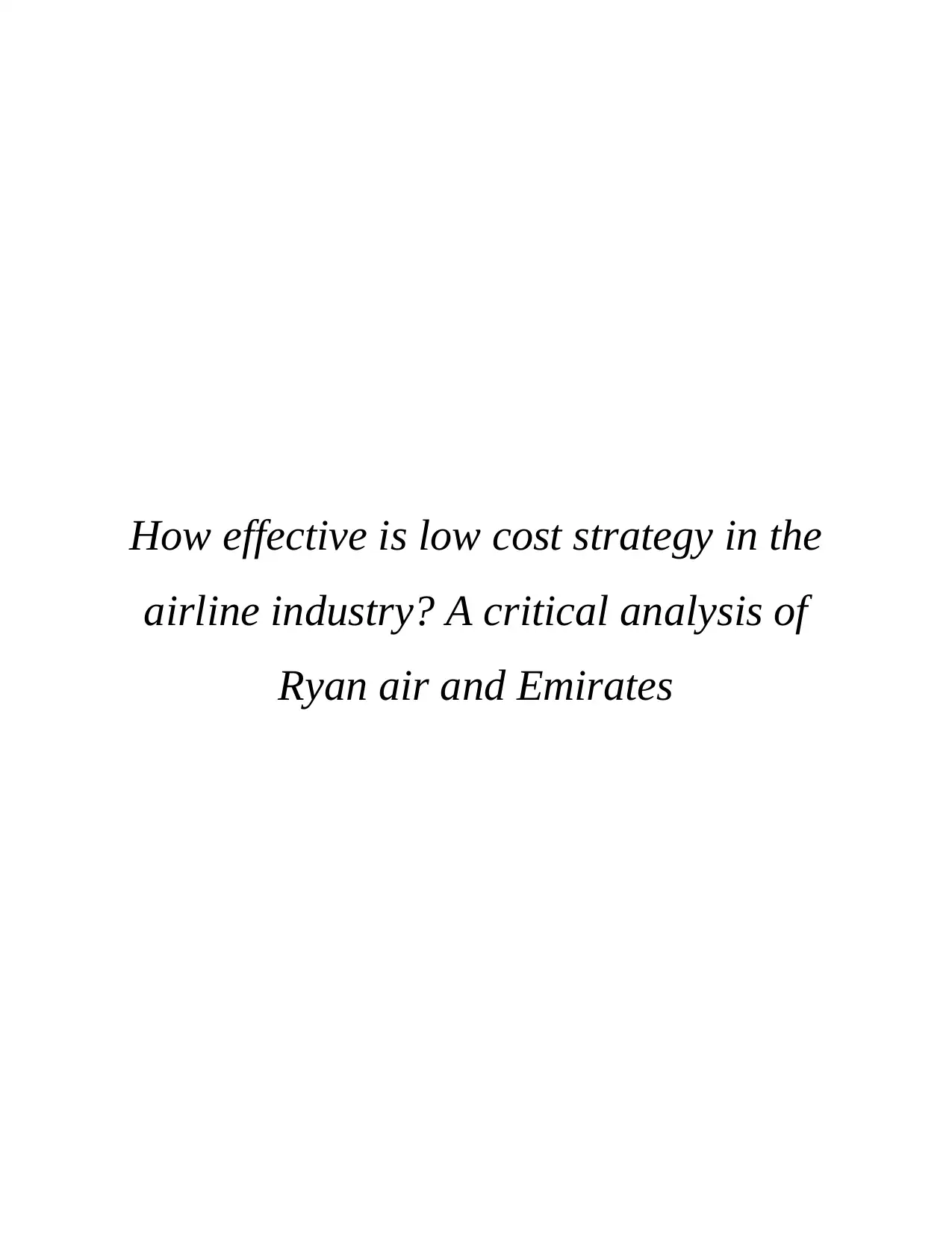
How effective is low cost strategy in the
airline industry? A critical analysis of
Ryan air and Emirates
airline industry? A critical analysis of
Ryan air and Emirates
Paraphrase This Document
Need a fresh take? Get an instant paraphrase of this document with our AI Paraphraser
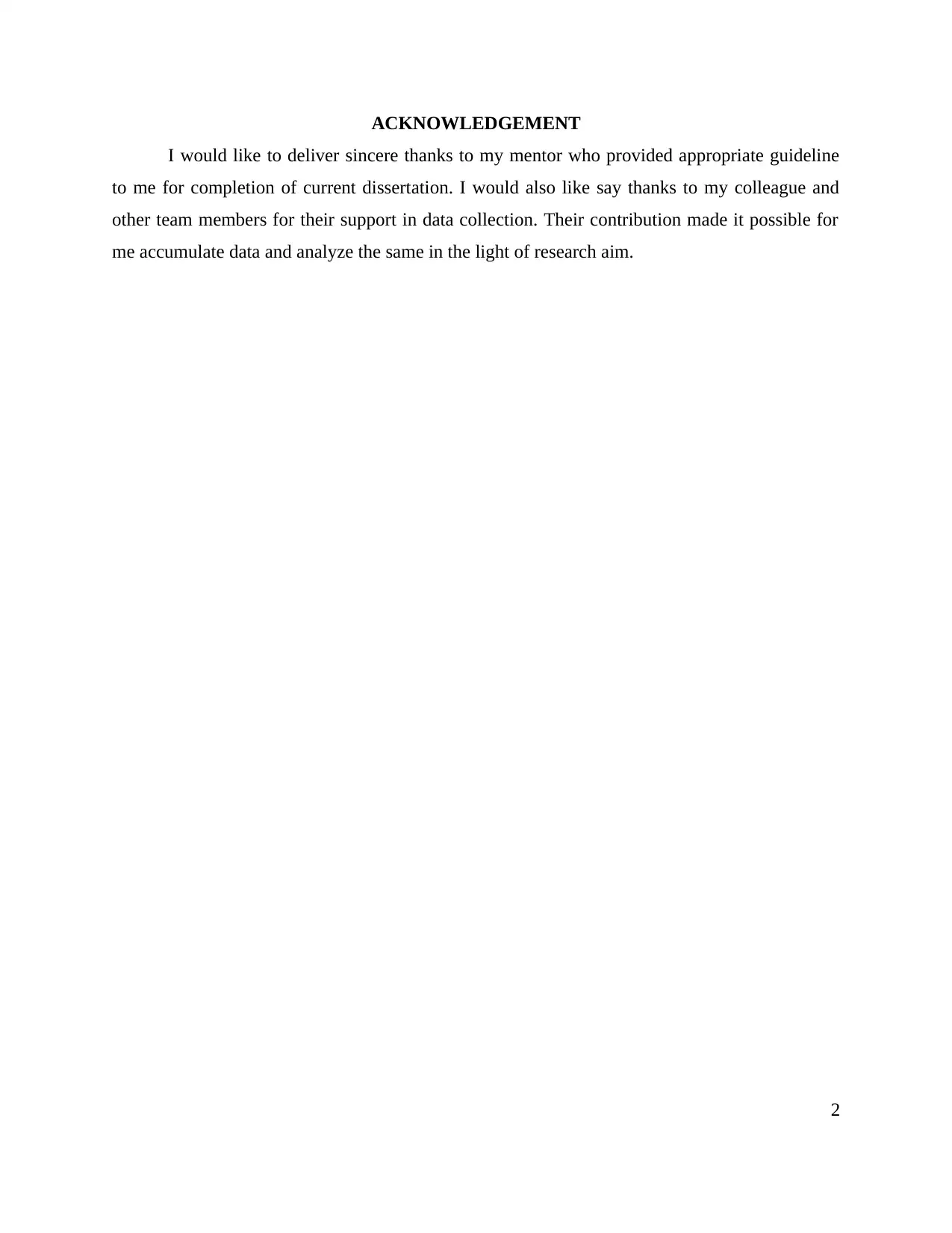
ACKNOWLEDGEMENT
I would like to deliver sincere thanks to my mentor who provided appropriate guideline
to me for completion of current dissertation. I would also like say thanks to my colleague and
other team members for their support in data collection. Their contribution made it possible for
me accumulate data and analyze the same in the light of research aim.
2
I would like to deliver sincere thanks to my mentor who provided appropriate guideline
to me for completion of current dissertation. I would also like say thanks to my colleague and
other team members for their support in data collection. Their contribution made it possible for
me accumulate data and analyze the same in the light of research aim.
2
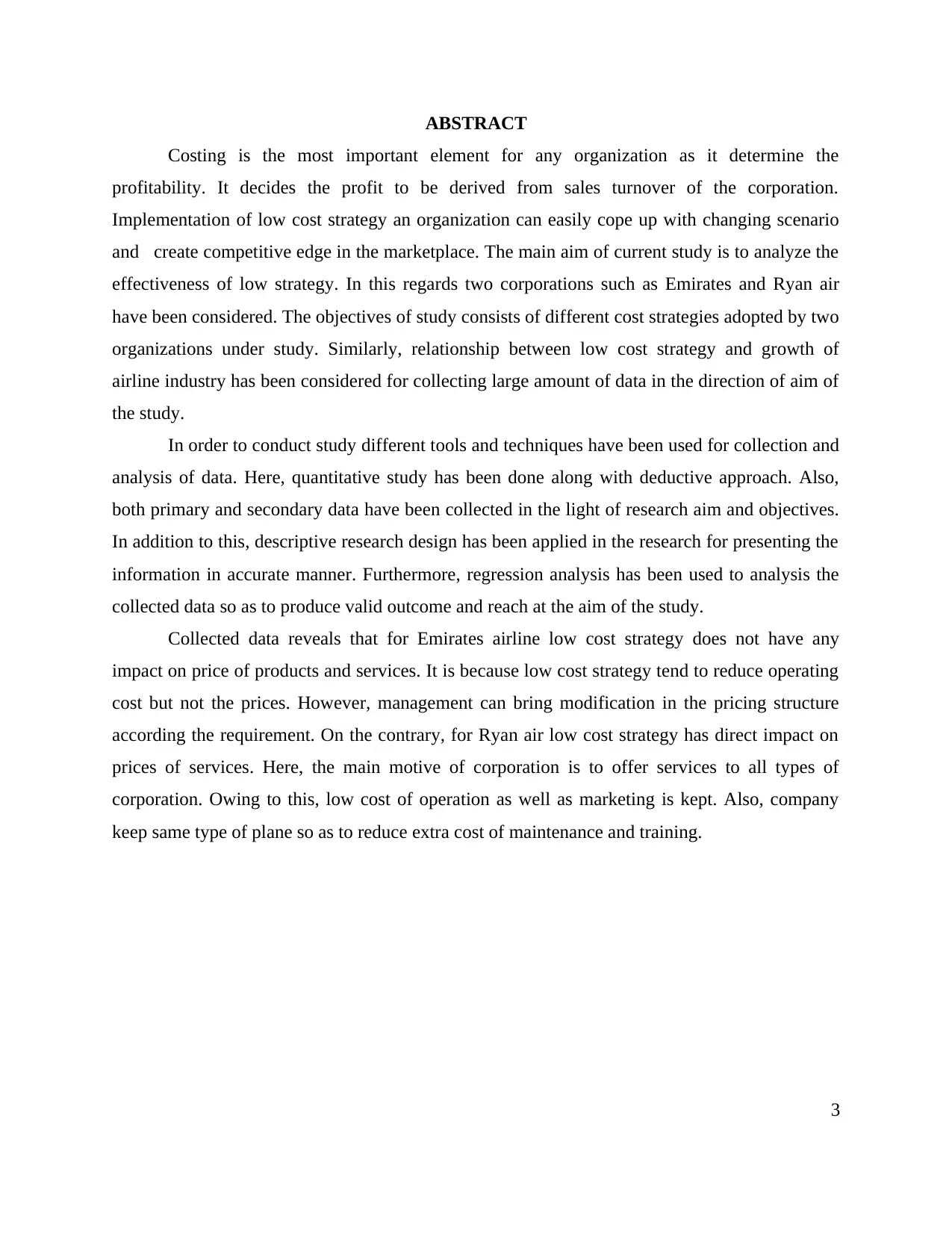
ABSTRACT
Costing is the most important element for any organization as it determine the
profitability. It decides the profit to be derived from sales turnover of the corporation.
Implementation of low cost strategy an organization can easily cope up with changing scenario
and create competitive edge in the marketplace. The main aim of current study is to analyze the
effectiveness of low strategy. In this regards two corporations such as Emirates and Ryan air
have been considered. The objectives of study consists of different cost strategies adopted by two
organizations under study. Similarly, relationship between low cost strategy and growth of
airline industry has been considered for collecting large amount of data in the direction of aim of
the study.
In order to conduct study different tools and techniques have been used for collection and
analysis of data. Here, quantitative study has been done along with deductive approach. Also,
both primary and secondary data have been collected in the light of research aim and objectives.
In addition to this, descriptive research design has been applied in the research for presenting the
information in accurate manner. Furthermore, regression analysis has been used to analysis the
collected data so as to produce valid outcome and reach at the aim of the study.
Collected data reveals that for Emirates airline low cost strategy does not have any
impact on price of products and services. It is because low cost strategy tend to reduce operating
cost but not the prices. However, management can bring modification in the pricing structure
according the requirement. On the contrary, for Ryan air low cost strategy has direct impact on
prices of services. Here, the main motive of corporation is to offer services to all types of
corporation. Owing to this, low cost of operation as well as marketing is kept. Also, company
keep same type of plane so as to reduce extra cost of maintenance and training.
3
Costing is the most important element for any organization as it determine the
profitability. It decides the profit to be derived from sales turnover of the corporation.
Implementation of low cost strategy an organization can easily cope up with changing scenario
and create competitive edge in the marketplace. The main aim of current study is to analyze the
effectiveness of low strategy. In this regards two corporations such as Emirates and Ryan air
have been considered. The objectives of study consists of different cost strategies adopted by two
organizations under study. Similarly, relationship between low cost strategy and growth of
airline industry has been considered for collecting large amount of data in the direction of aim of
the study.
In order to conduct study different tools and techniques have been used for collection and
analysis of data. Here, quantitative study has been done along with deductive approach. Also,
both primary and secondary data have been collected in the light of research aim and objectives.
In addition to this, descriptive research design has been applied in the research for presenting the
information in accurate manner. Furthermore, regression analysis has been used to analysis the
collected data so as to produce valid outcome and reach at the aim of the study.
Collected data reveals that for Emirates airline low cost strategy does not have any
impact on price of products and services. It is because low cost strategy tend to reduce operating
cost but not the prices. However, management can bring modification in the pricing structure
according the requirement. On the contrary, for Ryan air low cost strategy has direct impact on
prices of services. Here, the main motive of corporation is to offer services to all types of
corporation. Owing to this, low cost of operation as well as marketing is kept. Also, company
keep same type of plane so as to reduce extra cost of maintenance and training.
3
⊘ This is a preview!⊘
Do you want full access?
Subscribe today to unlock all pages.

Trusted by 1+ million students worldwide

TABLE OF CONTENTS
CHPATER 1: introduction...............................................................................................................7
1.1 Background of research.........................................................................................................7
1.2 Statement of problem.............................................................................................................9
1.3 Rationale of research............................................................................................................10
1.4 research questions................................................................................................................10
1.5 Research aim and objectives................................................................................................10
1.6 Research methodology.........................................................................................................11
1.7 Structure of research ...........................................................................................................11
CHAPTER 2: LITERATURE REVIEW.......................................................................................14
2.1 Introduction..........................................................................................................................14
2.2 Cost strategies adopted by the businesses in Airline industry.............................................14
2.3 Importance of low cost strategy for Emirates and Ryan air.................................................17
2.4 Relationship between low cost strategy and growth of Emirates and Ryan air...................20
CHAPTER 3: SCOPE OF RESEARCH .......................................................................................23
3.1 Introduction..........................................................................................................................23
3.2 Operations of the sector.......................................................................................................23
3.3 Performance of sector..........................................................................................................23
3.4 Major challenges facing the sectors.....................................................................................24
3.5 Current issues in context of the sector.................................................................................24
3.6 Justification of the choice of the firm..................................................................................25
3.7 Conclusion...........................................................................................................................25
CHAPTER 4: RESESEARCH METHODOLOGY......................................................................26
4.1 Introduction..........................................................................................................................26
4.2 Research philosophy............................................................................................................26
4.3 Research design...................................................................................................................27
4.4 Research approach ..............................................................................................................27
4.5 Data collection ....................................................................................................................28
4.6 Research methods................................................................................................................28
4.7 Ethical consideration............................................................................................................29
4.8 Sampling..............................................................................................................................29
4
CHPATER 1: introduction...............................................................................................................7
1.1 Background of research.........................................................................................................7
1.2 Statement of problem.............................................................................................................9
1.3 Rationale of research............................................................................................................10
1.4 research questions................................................................................................................10
1.5 Research aim and objectives................................................................................................10
1.6 Research methodology.........................................................................................................11
1.7 Structure of research ...........................................................................................................11
CHAPTER 2: LITERATURE REVIEW.......................................................................................14
2.1 Introduction..........................................................................................................................14
2.2 Cost strategies adopted by the businesses in Airline industry.............................................14
2.3 Importance of low cost strategy for Emirates and Ryan air.................................................17
2.4 Relationship between low cost strategy and growth of Emirates and Ryan air...................20
CHAPTER 3: SCOPE OF RESEARCH .......................................................................................23
3.1 Introduction..........................................................................................................................23
3.2 Operations of the sector.......................................................................................................23
3.3 Performance of sector..........................................................................................................23
3.4 Major challenges facing the sectors.....................................................................................24
3.5 Current issues in context of the sector.................................................................................24
3.6 Justification of the choice of the firm..................................................................................25
3.7 Conclusion...........................................................................................................................25
CHAPTER 4: RESESEARCH METHODOLOGY......................................................................26
4.1 Introduction..........................................................................................................................26
4.2 Research philosophy............................................................................................................26
4.3 Research design...................................................................................................................27
4.4 Research approach ..............................................................................................................27
4.5 Data collection ....................................................................................................................28
4.6 Research methods................................................................................................................28
4.7 Ethical consideration............................................................................................................29
4.8 Sampling..............................................................................................................................29
4
Paraphrase This Document
Need a fresh take? Get an instant paraphrase of this document with our AI Paraphraser
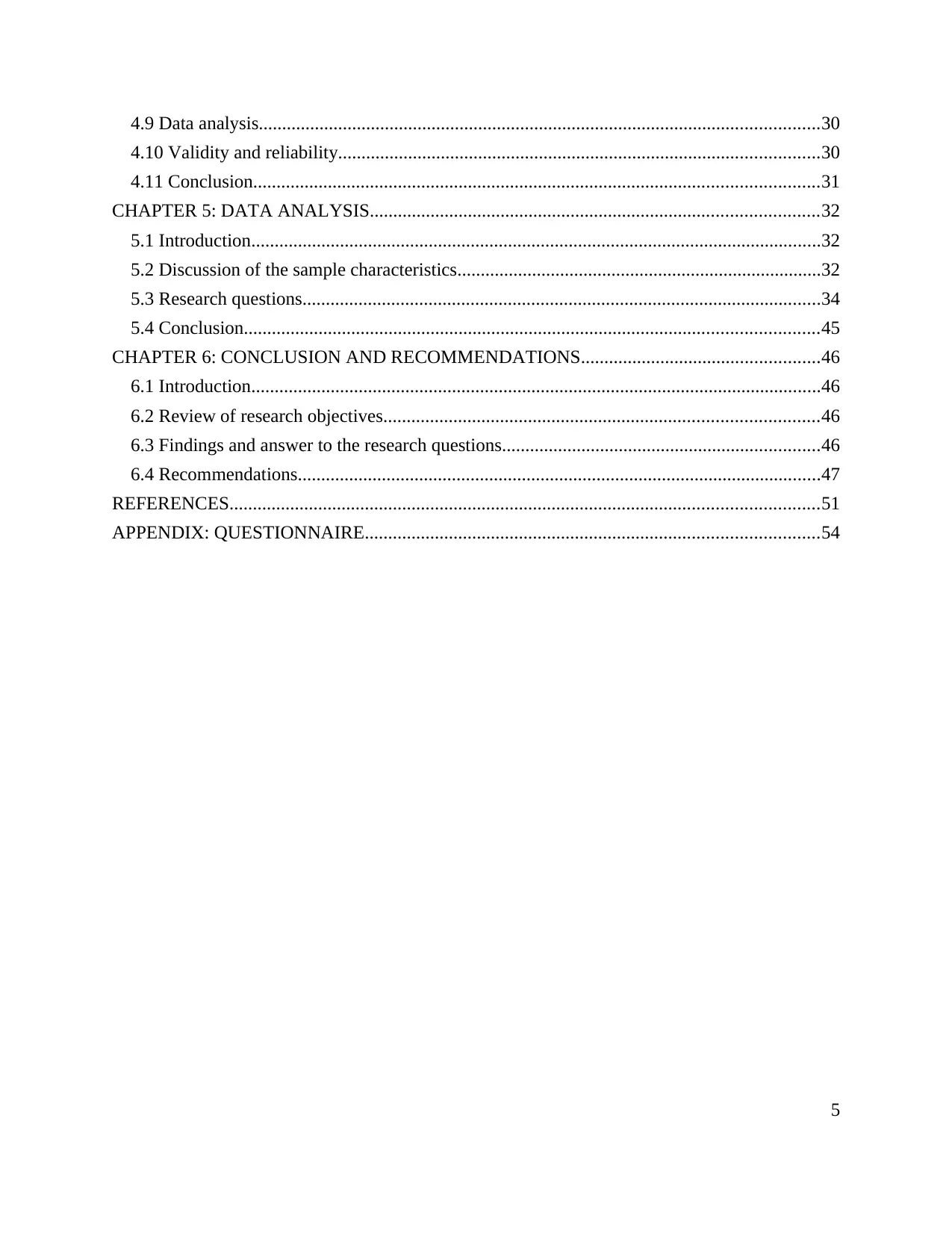
4.9 Data analysis........................................................................................................................30
4.10 Validity and reliability.......................................................................................................30
4.11 Conclusion.........................................................................................................................31
CHAPTER 5: DATA ANALYSIS................................................................................................32
5.1 Introduction..........................................................................................................................32
5.2 Discussion of the sample characteristics..............................................................................32
5.3 Research questions...............................................................................................................34
5.4 Conclusion...........................................................................................................................45
CHAPTER 6: CONCLUSION AND RECOMMENDATIONS...................................................46
6.1 Introduction..........................................................................................................................46
6.2 Review of research objectives.............................................................................................46
6.3 Findings and answer to the research questions....................................................................46
6.4 Recommendations................................................................................................................47
REFERENCES..............................................................................................................................51
APPENDIX: QUESTIONNAIRE.................................................................................................54
5
4.10 Validity and reliability.......................................................................................................30
4.11 Conclusion.........................................................................................................................31
CHAPTER 5: DATA ANALYSIS................................................................................................32
5.1 Introduction..........................................................................................................................32
5.2 Discussion of the sample characteristics..............................................................................32
5.3 Research questions...............................................................................................................34
5.4 Conclusion...........................................................................................................................45
CHAPTER 6: CONCLUSION AND RECOMMENDATIONS...................................................46
6.1 Introduction..........................................................................................................................46
6.2 Review of research objectives.............................................................................................46
6.3 Findings and answer to the research questions....................................................................46
6.4 Recommendations................................................................................................................47
REFERENCES..............................................................................................................................51
APPENDIX: QUESTIONNAIRE.................................................................................................54
5
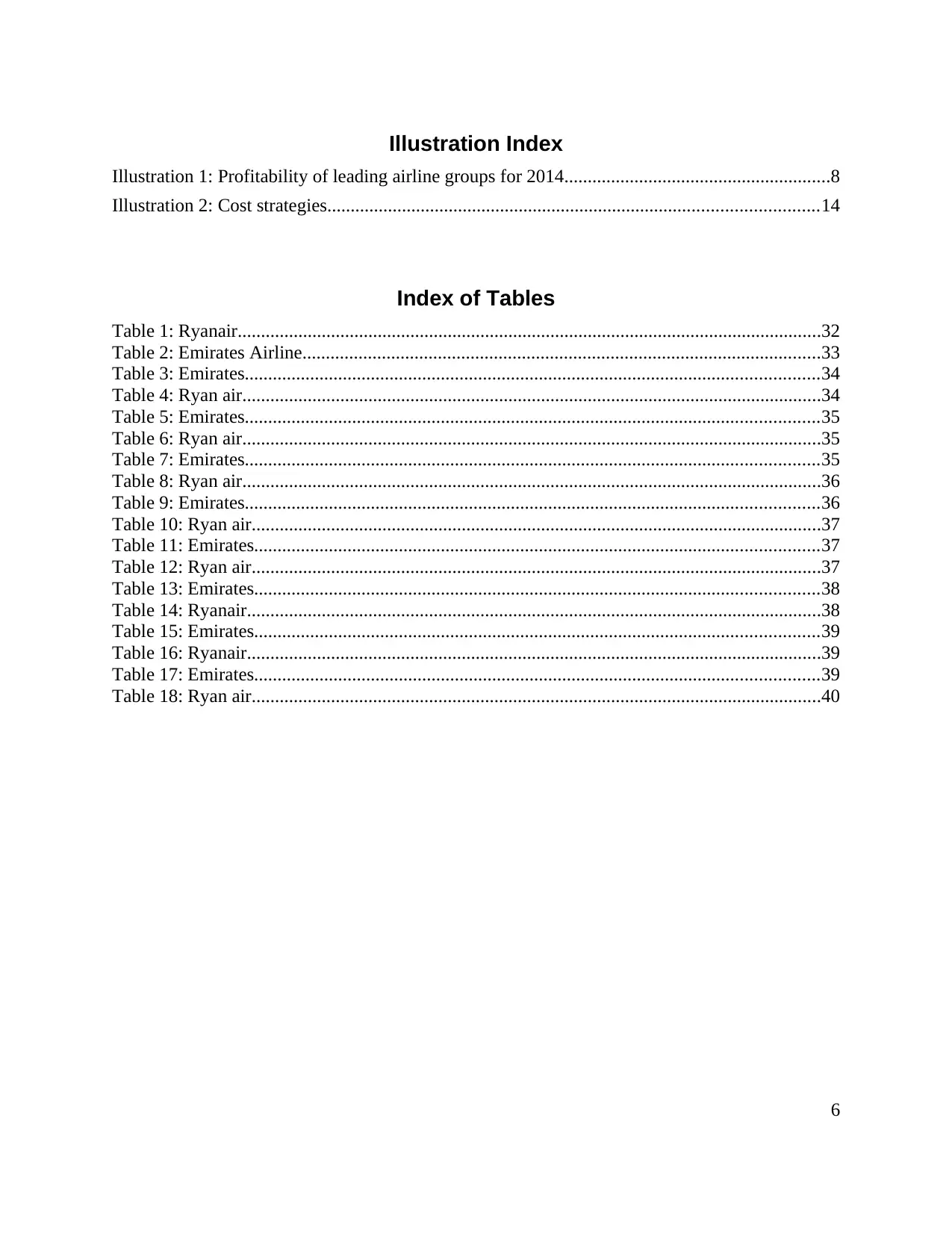
Illustration Index
Illustration 1: Profitability of leading airline groups for 2014.........................................................8
Illustration 2: Cost strategies.........................................................................................................14
Index of Tables
Table 1: Ryanair.............................................................................................................................32
Table 2: Emirates Airline...............................................................................................................33
Table 3: Emirates...........................................................................................................................34
Table 4: Ryan air............................................................................................................................34
Table 5: Emirates...........................................................................................................................35
Table 6: Ryan air............................................................................................................................35
Table 7: Emirates...........................................................................................................................35
Table 8: Ryan air............................................................................................................................36
Table 9: Emirates...........................................................................................................................36
Table 10: Ryan air..........................................................................................................................37
Table 11: Emirates.........................................................................................................................37
Table 12: Ryan air..........................................................................................................................37
Table 13: Emirates.........................................................................................................................38
Table 14: Ryanair...........................................................................................................................38
Table 15: Emirates.........................................................................................................................39
Table 16: Ryanair...........................................................................................................................39
Table 17: Emirates.........................................................................................................................39
Table 18: Ryan air..........................................................................................................................40
6
Illustration 1: Profitability of leading airline groups for 2014.........................................................8
Illustration 2: Cost strategies.........................................................................................................14
Index of Tables
Table 1: Ryanair.............................................................................................................................32
Table 2: Emirates Airline...............................................................................................................33
Table 3: Emirates...........................................................................................................................34
Table 4: Ryan air............................................................................................................................34
Table 5: Emirates...........................................................................................................................35
Table 6: Ryan air............................................................................................................................35
Table 7: Emirates...........................................................................................................................35
Table 8: Ryan air............................................................................................................................36
Table 9: Emirates...........................................................................................................................36
Table 10: Ryan air..........................................................................................................................37
Table 11: Emirates.........................................................................................................................37
Table 12: Ryan air..........................................................................................................................37
Table 13: Emirates.........................................................................................................................38
Table 14: Ryanair...........................................................................................................................38
Table 15: Emirates.........................................................................................................................39
Table 16: Ryanair...........................................................................................................................39
Table 17: Emirates.........................................................................................................................39
Table 18: Ryan air..........................................................................................................................40
6
⊘ This is a preview!⊘
Do you want full access?
Subscribe today to unlock all pages.

Trusted by 1+ million students worldwide
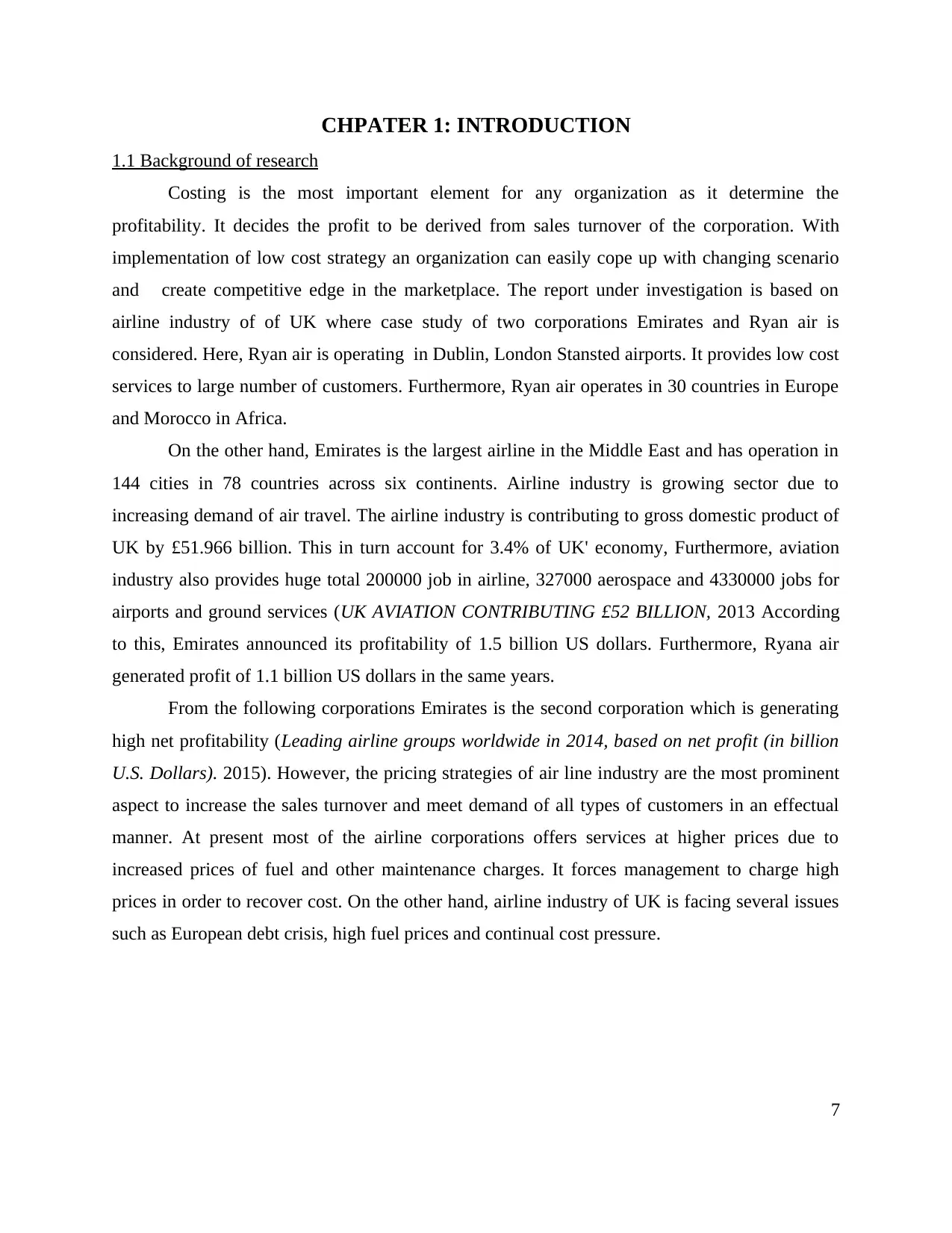
CHPATER 1: INTRODUCTION
1.1 Background of research
Costing is the most important element for any organization as it determine the
profitability. It decides the profit to be derived from sales turnover of the corporation. With
implementation of low cost strategy an organization can easily cope up with changing scenario
and create competitive edge in the marketplace. The report under investigation is based on
airline industry of of UK where case study of two corporations Emirates and Ryan air is
considered. Here, Ryan air is operating in Dublin, London Stansted airports. It provides low cost
services to large number of customers. Furthermore, Ryan air operates in 30 countries in Europe
and Morocco in Africa.
On the other hand, Emirates is the largest airline in the Middle East and has operation in
144 cities in 78 countries across six continents. Airline industry is growing sector due to
increasing demand of air travel. The airline industry is contributing to gross domestic product of
UK by £51.966 billion. This in turn account for 3.4% of UK' economy, Furthermore, aviation
industry also provides huge total 200000 job in airline, 327000 aerospace and 4330000 jobs for
airports and ground services (UK AVIATION CONTRIBUTING £52 BILLION, 2013 According
to this, Emirates announced its profitability of 1.5 billion US dollars. Furthermore, Ryana air
generated profit of 1.1 billion US dollars in the same years.
From the following corporations Emirates is the second corporation which is generating
high net profitability (Leading airline groups worldwide in 2014, based on net profit (in billion
U.S. Dollars). 2015). However, the pricing strategies of air line industry are the most prominent
aspect to increase the sales turnover and meet demand of all types of customers in an effectual
manner. At present most of the airline corporations offers services at higher prices due to
increased prices of fuel and other maintenance charges. It forces management to charge high
prices in order to recover cost. On the other hand, airline industry of UK is facing several issues
such as European debt crisis, high fuel prices and continual cost pressure.
7
1.1 Background of research
Costing is the most important element for any organization as it determine the
profitability. It decides the profit to be derived from sales turnover of the corporation. With
implementation of low cost strategy an organization can easily cope up with changing scenario
and create competitive edge in the marketplace. The report under investigation is based on
airline industry of of UK where case study of two corporations Emirates and Ryan air is
considered. Here, Ryan air is operating in Dublin, London Stansted airports. It provides low cost
services to large number of customers. Furthermore, Ryan air operates in 30 countries in Europe
and Morocco in Africa.
On the other hand, Emirates is the largest airline in the Middle East and has operation in
144 cities in 78 countries across six continents. Airline industry is growing sector due to
increasing demand of air travel. The airline industry is contributing to gross domestic product of
UK by £51.966 billion. This in turn account for 3.4% of UK' economy, Furthermore, aviation
industry also provides huge total 200000 job in airline, 327000 aerospace and 4330000 jobs for
airports and ground services (UK AVIATION CONTRIBUTING £52 BILLION, 2013 According
to this, Emirates announced its profitability of 1.5 billion US dollars. Furthermore, Ryana air
generated profit of 1.1 billion US dollars in the same years.
From the following corporations Emirates is the second corporation which is generating
high net profitability (Leading airline groups worldwide in 2014, based on net profit (in billion
U.S. Dollars). 2015). However, the pricing strategies of air line industry are the most prominent
aspect to increase the sales turnover and meet demand of all types of customers in an effectual
manner. At present most of the airline corporations offers services at higher prices due to
increased prices of fuel and other maintenance charges. It forces management to charge high
prices in order to recover cost. On the other hand, airline industry of UK is facing several issues
such as European debt crisis, high fuel prices and continual cost pressure.
7
Paraphrase This Document
Need a fresh take? Get an instant paraphrase of this document with our AI Paraphraser
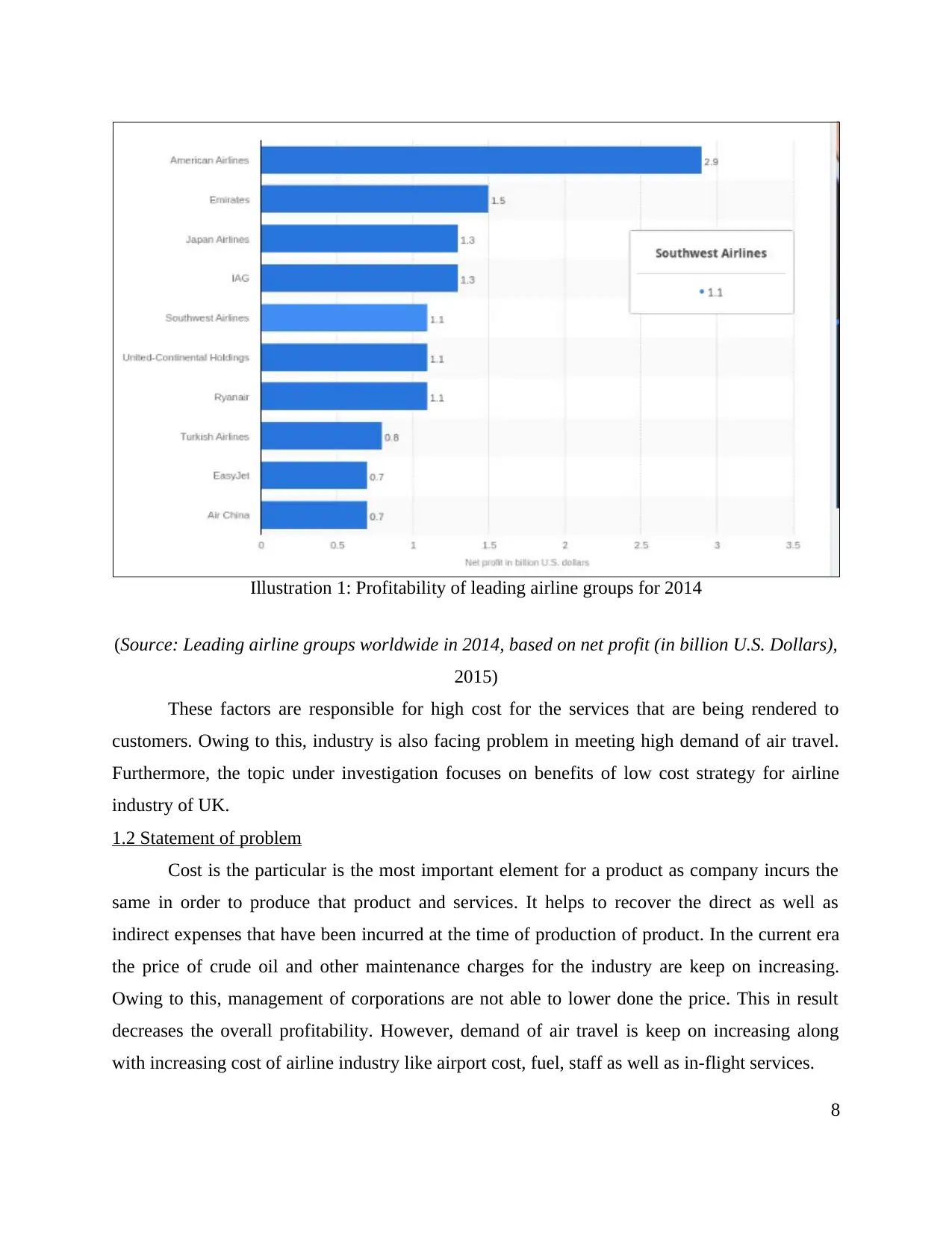
(Source: Leading airline groups worldwide in 2014, based on net profit (in billion U.S. Dollars),
2015)
These factors are responsible for high cost for the services that are being rendered to
customers. Owing to this, industry is also facing problem in meeting high demand of air travel.
Furthermore, the topic under investigation focuses on benefits of low cost strategy for airline
industry of UK.
1.2 Statement of problem
Cost is the particular is the most important element for a product as company incurs the
same in order to produce that product and services. It helps to recover the direct as well as
indirect expenses that have been incurred at the time of production of product. In the current era
the price of crude oil and other maintenance charges for the industry are keep on increasing.
Owing to this, management of corporations are not able to lower done the price. This in result
decreases the overall profitability. However, demand of air travel is keep on increasing along
with increasing cost of airline industry like airport cost, fuel, staff as well as in-flight services.
8
Illustration 1: Profitability of leading airline groups for 2014
2015)
These factors are responsible for high cost for the services that are being rendered to
customers. Owing to this, industry is also facing problem in meeting high demand of air travel.
Furthermore, the topic under investigation focuses on benefits of low cost strategy for airline
industry of UK.
1.2 Statement of problem
Cost is the particular is the most important element for a product as company incurs the
same in order to produce that product and services. It helps to recover the direct as well as
indirect expenses that have been incurred at the time of production of product. In the current era
the price of crude oil and other maintenance charges for the industry are keep on increasing.
Owing to this, management of corporations are not able to lower done the price. This in result
decreases the overall profitability. However, demand of air travel is keep on increasing along
with increasing cost of airline industry like airport cost, fuel, staff as well as in-flight services.
8
Illustration 1: Profitability of leading airline groups for 2014
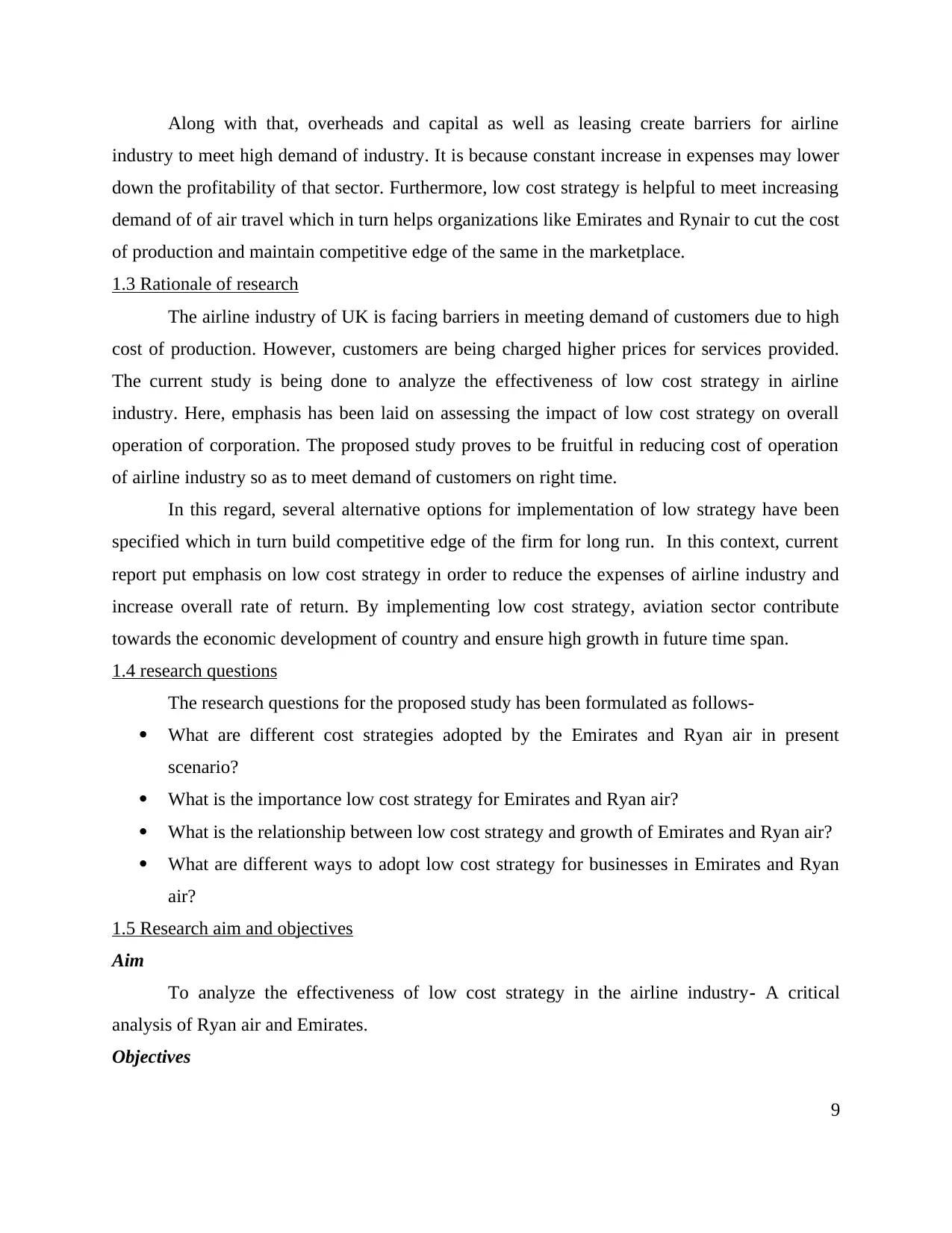
Along with that, overheads and capital as well as leasing create barriers for airline
industry to meet high demand of industry. It is because constant increase in expenses may lower
down the profitability of that sector. Furthermore, low cost strategy is helpful to meet increasing
demand of of air travel which in turn helps organizations like Emirates and Rynair to cut the cost
of production and maintain competitive edge of the same in the marketplace.
1.3 Rationale of research
The airline industry of UK is facing barriers in meeting demand of customers due to high
cost of production. However, customers are being charged higher prices for services provided.
The current study is being done to analyze the effectiveness of low cost strategy in airline
industry. Here, emphasis has been laid on assessing the impact of low cost strategy on overall
operation of corporation. The proposed study proves to be fruitful in reducing cost of operation
of airline industry so as to meet demand of customers on right time.
In this regard, several alternative options for implementation of low strategy have been
specified which in turn build competitive edge of the firm for long run. In this context, current
report put emphasis on low cost strategy in order to reduce the expenses of airline industry and
increase overall rate of return. By implementing low cost strategy, aviation sector contribute
towards the economic development of country and ensure high growth in future time span.
1.4 research questions
The research questions for the proposed study has been formulated as follows-
What are different cost strategies adopted by the Emirates and Ryan air in present
scenario?
What is the importance low cost strategy for Emirates and Ryan air?
What is the relationship between low cost strategy and growth of Emirates and Ryan air?
What are different ways to adopt low cost strategy for businesses in Emirates and Ryan
air?
1.5 Research aim and objectives
Aim
To analyze the effectiveness of low cost strategy in the airline industry- A critical
analysis of Ryan air and Emirates.
Objectives
9
industry to meet high demand of industry. It is because constant increase in expenses may lower
down the profitability of that sector. Furthermore, low cost strategy is helpful to meet increasing
demand of of air travel which in turn helps organizations like Emirates and Rynair to cut the cost
of production and maintain competitive edge of the same in the marketplace.
1.3 Rationale of research
The airline industry of UK is facing barriers in meeting demand of customers due to high
cost of production. However, customers are being charged higher prices for services provided.
The current study is being done to analyze the effectiveness of low cost strategy in airline
industry. Here, emphasis has been laid on assessing the impact of low cost strategy on overall
operation of corporation. The proposed study proves to be fruitful in reducing cost of operation
of airline industry so as to meet demand of customers on right time.
In this regard, several alternative options for implementation of low strategy have been
specified which in turn build competitive edge of the firm for long run. In this context, current
report put emphasis on low cost strategy in order to reduce the expenses of airline industry and
increase overall rate of return. By implementing low cost strategy, aviation sector contribute
towards the economic development of country and ensure high growth in future time span.
1.4 research questions
The research questions for the proposed study has been formulated as follows-
What are different cost strategies adopted by the Emirates and Ryan air in present
scenario?
What is the importance low cost strategy for Emirates and Ryan air?
What is the relationship between low cost strategy and growth of Emirates and Ryan air?
What are different ways to adopt low cost strategy for businesses in Emirates and Ryan
air?
1.5 Research aim and objectives
Aim
To analyze the effectiveness of low cost strategy in the airline industry- A critical
analysis of Ryan air and Emirates.
Objectives
9
⊘ This is a preview!⊘
Do you want full access?
Subscribe today to unlock all pages.

Trusted by 1+ million students worldwide
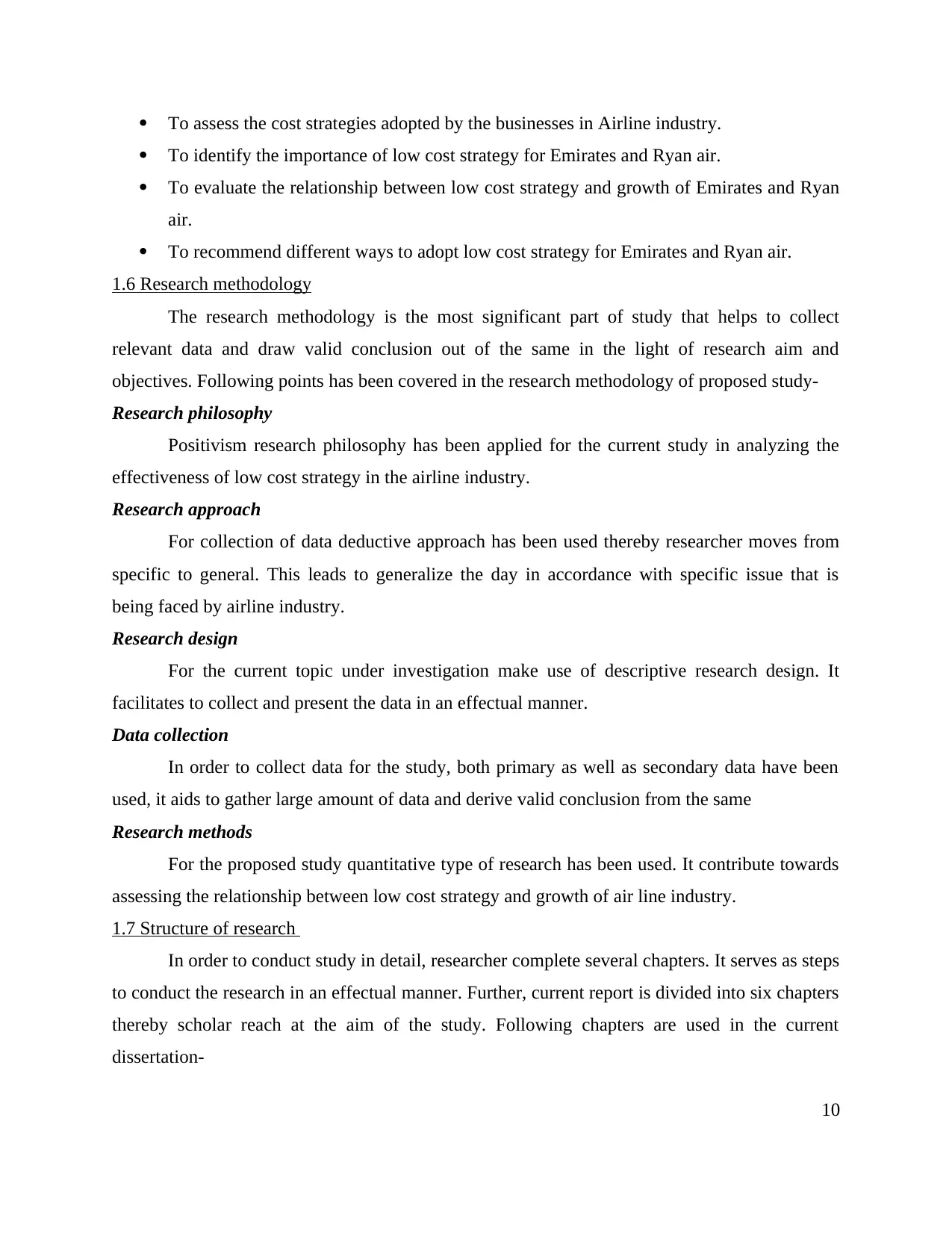
To assess the cost strategies adopted by the businesses in Airline industry.
To identify the importance of low cost strategy for Emirates and Ryan air.
To evaluate the relationship between low cost strategy and growth of Emirates and Ryan
air.
To recommend different ways to adopt low cost strategy for Emirates and Ryan air.
1.6 Research methodology
The research methodology is the most significant part of study that helps to collect
relevant data and draw valid conclusion out of the same in the light of research aim and
objectives. Following points has been covered in the research methodology of proposed study-
Research philosophy
Positivism research philosophy has been applied for the current study in analyzing the
effectiveness of low cost strategy in the airline industry.
Research approach
For collection of data deductive approach has been used thereby researcher moves from
specific to general. This leads to generalize the day in accordance with specific issue that is
being faced by airline industry.
Research design
For the current topic under investigation make use of descriptive research design. It
facilitates to collect and present the data in an effectual manner.
Data collection
In order to collect data for the study, both primary as well as secondary data have been
used, it aids to gather large amount of data and derive valid conclusion from the same
Research methods
For the proposed study quantitative type of research has been used. It contribute towards
assessing the relationship between low cost strategy and growth of air line industry.
1.7 Structure of research
In order to conduct study in detail, researcher complete several chapters. It serves as steps
to conduct the research in an effectual manner. Further, current report is divided into six chapters
thereby scholar reach at the aim of the study. Following chapters are used in the current
dissertation-
10
To identify the importance of low cost strategy for Emirates and Ryan air.
To evaluate the relationship between low cost strategy and growth of Emirates and Ryan
air.
To recommend different ways to adopt low cost strategy for Emirates and Ryan air.
1.6 Research methodology
The research methodology is the most significant part of study that helps to collect
relevant data and draw valid conclusion out of the same in the light of research aim and
objectives. Following points has been covered in the research methodology of proposed study-
Research philosophy
Positivism research philosophy has been applied for the current study in analyzing the
effectiveness of low cost strategy in the airline industry.
Research approach
For collection of data deductive approach has been used thereby researcher moves from
specific to general. This leads to generalize the day in accordance with specific issue that is
being faced by airline industry.
Research design
For the current topic under investigation make use of descriptive research design. It
facilitates to collect and present the data in an effectual manner.
Data collection
In order to collect data for the study, both primary as well as secondary data have been
used, it aids to gather large amount of data and derive valid conclusion from the same
Research methods
For the proposed study quantitative type of research has been used. It contribute towards
assessing the relationship between low cost strategy and growth of air line industry.
1.7 Structure of research
In order to conduct study in detail, researcher complete several chapters. It serves as steps
to conduct the research in an effectual manner. Further, current report is divided into six chapters
thereby scholar reach at the aim of the study. Following chapters are used in the current
dissertation-
10
Paraphrase This Document
Need a fresh take? Get an instant paraphrase of this document with our AI Paraphraser
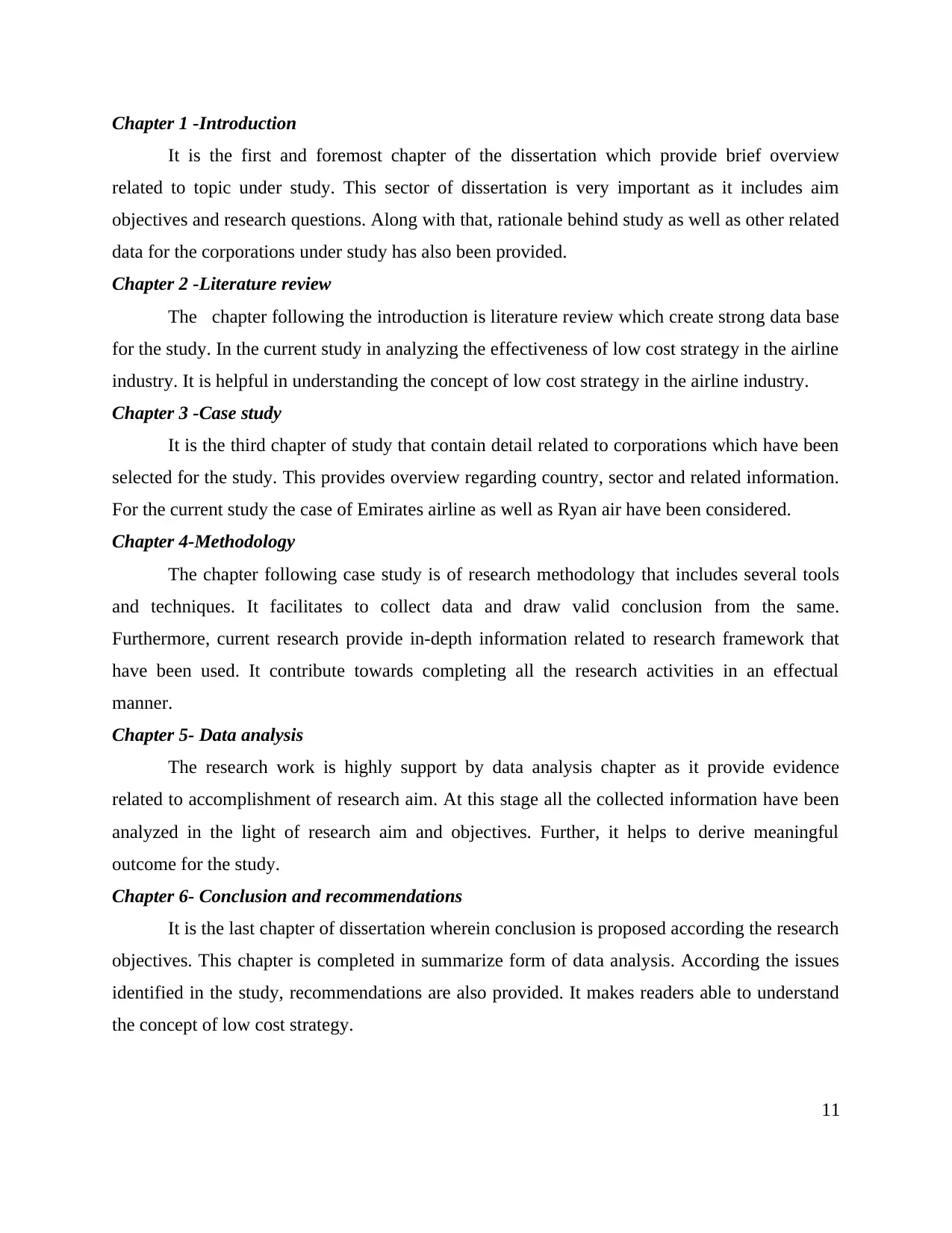
Chapter 1 -Introduction
It is the first and foremost chapter of the dissertation which provide brief overview
related to topic under study. This sector of dissertation is very important as it includes aim
objectives and research questions. Along with that, rationale behind study as well as other related
data for the corporations under study has also been provided.
Chapter 2 -Literature review
The chapter following the introduction is literature review which create strong data base
for the study. In the current study in analyzing the effectiveness of low cost strategy in the airline
industry. It is helpful in understanding the concept of low cost strategy in the airline industry.
Chapter 3 -Case study
It is the third chapter of study that contain detail related to corporations which have been
selected for the study. This provides overview regarding country, sector and related information.
For the current study the case of Emirates airline as well as Ryan air have been considered.
Chapter 4-Methodology
The chapter following case study is of research methodology that includes several tools
and techniques. It facilitates to collect data and draw valid conclusion from the same.
Furthermore, current research provide in-depth information related to research framework that
have been used. It contribute towards completing all the research activities in an effectual
manner.
Chapter 5- Data analysis
The research work is highly support by data analysis chapter as it provide evidence
related to accomplishment of research aim. At this stage all the collected information have been
analyzed in the light of research aim and objectives. Further, it helps to derive meaningful
outcome for the study.
Chapter 6- Conclusion and recommendations
It is the last chapter of dissertation wherein conclusion is proposed according the research
objectives. This chapter is completed in summarize form of data analysis. According the issues
identified in the study, recommendations are also provided. It makes readers able to understand
the concept of low cost strategy.
11
It is the first and foremost chapter of the dissertation which provide brief overview
related to topic under study. This sector of dissertation is very important as it includes aim
objectives and research questions. Along with that, rationale behind study as well as other related
data for the corporations under study has also been provided.
Chapter 2 -Literature review
The chapter following the introduction is literature review which create strong data base
for the study. In the current study in analyzing the effectiveness of low cost strategy in the airline
industry. It is helpful in understanding the concept of low cost strategy in the airline industry.
Chapter 3 -Case study
It is the third chapter of study that contain detail related to corporations which have been
selected for the study. This provides overview regarding country, sector and related information.
For the current study the case of Emirates airline as well as Ryan air have been considered.
Chapter 4-Methodology
The chapter following case study is of research methodology that includes several tools
and techniques. It facilitates to collect data and draw valid conclusion from the same.
Furthermore, current research provide in-depth information related to research framework that
have been used. It contribute towards completing all the research activities in an effectual
manner.
Chapter 5- Data analysis
The research work is highly support by data analysis chapter as it provide evidence
related to accomplishment of research aim. At this stage all the collected information have been
analyzed in the light of research aim and objectives. Further, it helps to derive meaningful
outcome for the study.
Chapter 6- Conclusion and recommendations
It is the last chapter of dissertation wherein conclusion is proposed according the research
objectives. This chapter is completed in summarize form of data analysis. According the issues
identified in the study, recommendations are also provided. It makes readers able to understand
the concept of low cost strategy.
11
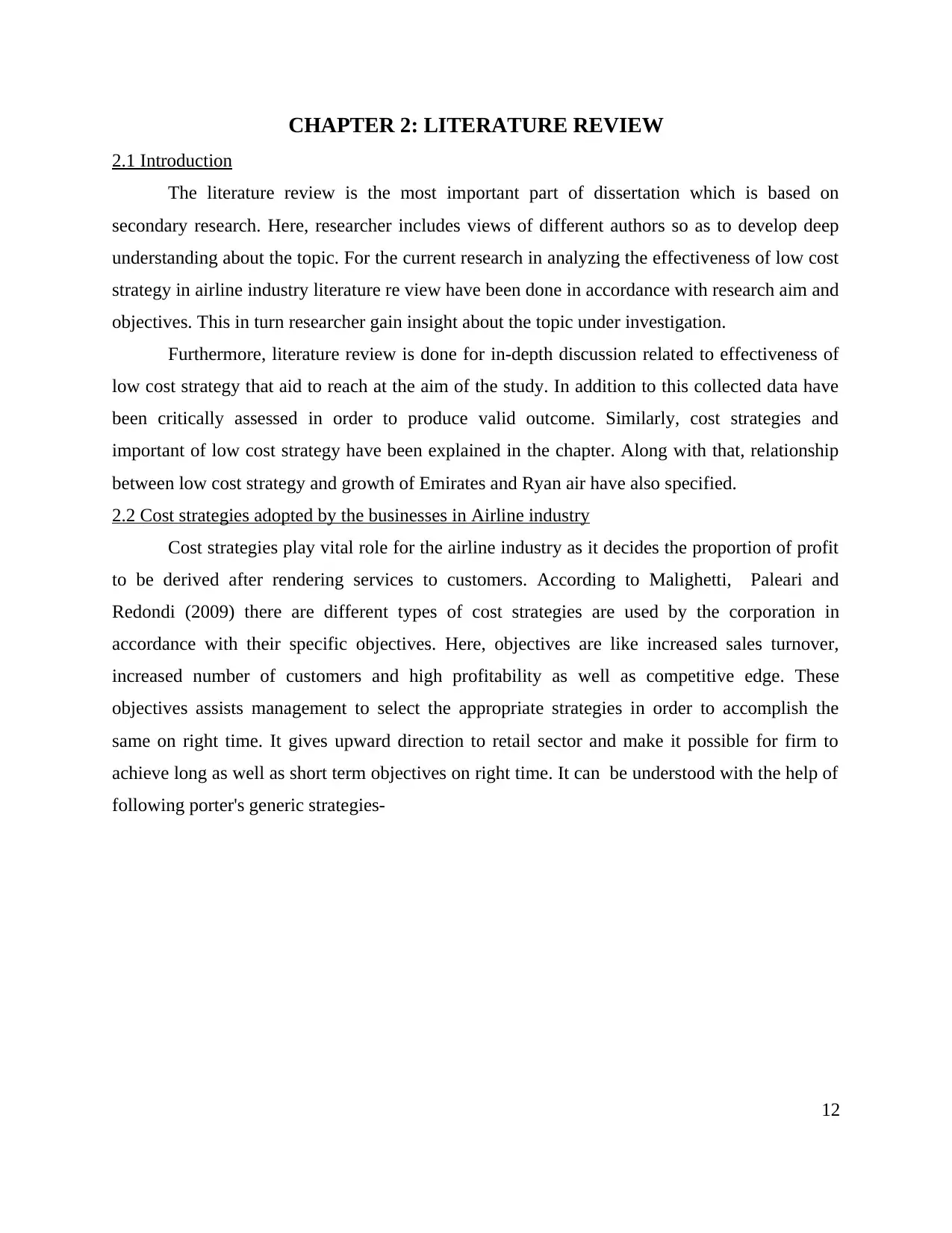
CHAPTER 2: LITERATURE REVIEW
2.1 Introduction
The literature review is the most important part of dissertation which is based on
secondary research. Here, researcher includes views of different authors so as to develop deep
understanding about the topic. For the current research in analyzing the effectiveness of low cost
strategy in airline industry literature re view have been done in accordance with research aim and
objectives. This in turn researcher gain insight about the topic under investigation.
Furthermore, literature review is done for in-depth discussion related to effectiveness of
low cost strategy that aid to reach at the aim of the study. In addition to this collected data have
been critically assessed in order to produce valid outcome. Similarly, cost strategies and
important of low cost strategy have been explained in the chapter. Along with that, relationship
between low cost strategy and growth of Emirates and Ryan air have also specified.
2.2 Cost strategies adopted by the businesses in Airline industry
Cost strategies play vital role for the airline industry as it decides the proportion of profit
to be derived after rendering services to customers. According to Malighetti, Paleari and
Redondi (2009) there are different types of cost strategies are used by the corporation in
accordance with their specific objectives. Here, objectives are like increased sales turnover,
increased number of customers and high profitability as well as competitive edge. These
objectives assists management to select the appropriate strategies in order to accomplish the
same on right time. It gives upward direction to retail sector and make it possible for firm to
achieve long as well as short term objectives on right time. It can be understood with the help of
following porter's generic strategies-
12
2.1 Introduction
The literature review is the most important part of dissertation which is based on
secondary research. Here, researcher includes views of different authors so as to develop deep
understanding about the topic. For the current research in analyzing the effectiveness of low cost
strategy in airline industry literature re view have been done in accordance with research aim and
objectives. This in turn researcher gain insight about the topic under investigation.
Furthermore, literature review is done for in-depth discussion related to effectiveness of
low cost strategy that aid to reach at the aim of the study. In addition to this collected data have
been critically assessed in order to produce valid outcome. Similarly, cost strategies and
important of low cost strategy have been explained in the chapter. Along with that, relationship
between low cost strategy and growth of Emirates and Ryan air have also specified.
2.2 Cost strategies adopted by the businesses in Airline industry
Cost strategies play vital role for the airline industry as it decides the proportion of profit
to be derived after rendering services to customers. According to Malighetti, Paleari and
Redondi (2009) there are different types of cost strategies are used by the corporation in
accordance with their specific objectives. Here, objectives are like increased sales turnover,
increased number of customers and high profitability as well as competitive edge. These
objectives assists management to select the appropriate strategies in order to accomplish the
same on right time. It gives upward direction to retail sector and make it possible for firm to
achieve long as well as short term objectives on right time. It can be understood with the help of
following porter's generic strategies-
12
⊘ This is a preview!⊘
Do you want full access?
Subscribe today to unlock all pages.

Trusted by 1+ million students worldwide
1 out of 54